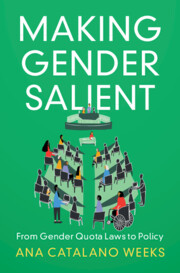Book contents
- Frontmatter
- Dedication
- Contents
- List of Figures
- List of Tables
- Acknowledgments
- 1 Introduction
- 2 When Do Quotas Matter? A Theory of the Substantive Representation of Cross-Cutting Interests
- 3 What Do Women Want? Gender Gaps in Preferences
- 4 The First Stage of Policy Change: The Effects of Quotas on Party Priorities
- 5 The Effects of Gender Quota Laws on Work–Family Policies
- 6 How Gender Quota Laws Change Work–Family Policies
- 7 Conclusion
- Appendix
- References
- Index
5 - The Effects of Gender Quota Laws on Work–Family Policies
Published online by Cambridge University Press: 09 June 2022
- Frontmatter
- Dedication
- Contents
- List of Figures
- List of Tables
- Acknowledgments
- 1 Introduction
- 2 When Do Quotas Matter? A Theory of the Substantive Representation of Cross-Cutting Interests
- 3 What Do Women Want? Gender Gaps in Preferences
- 4 The First Stage of Policy Change: The Effects of Quotas on Party Priorities
- 5 The Effects of Gender Quota Laws on Work–Family Policies
- 6 How Gender Quota Laws Change Work–Family Policies
- 7 Conclusion
- Appendix
- References
- Index
Summary
Chapter 5 tackles the question of whether quotas lead to real policy changes. I examine data on public spending on family policies and the composition of leave policies. Work--family policies have evolved rapidly, and I look for evidence that quotas are linked to policies that support mothers working outside the home -- specifically, paid leave that can be shared by parents and paternity-only leave, as opposed to maternity-only leave and family allowances (both of which reinforce gender stereotypes of care). I find that quotas shift the configuration of leave policies towards gender equality -- more paid parental and father-specific leave, and less maternity-only leave. The size of these effects is influenced by how effectively the quota increased the number of women in office (the “quota shock”): the larger the quota shock, the greater the policy shifts observed. I find no evidence of change to spending in areas in which men and women tend to have similar policy preferences, or where issues fall within the bounds of the mainstream, left--right policy dimension (like overall social spending). A key finding from Chapter 5 is that quota laws affect policies: they shift the spending and composition of work--family policies to better support women’s preferences on maternal employment.
Keywords
- Type
- Chapter
- Information
- Making Gender SalientFrom Gender Quota Laws to Policy, pp. 92 - 118Publisher: Cambridge University PressPrint publication year: 2022

